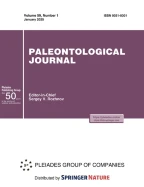Abstract
This article examines the geological and stratigraphic context of several types dinosaur tracks discovered in Lower Cretaceous deposits exposed in the vicinity of city of Kislovodsk (Caucasian Spa Country; Stavropol Krai). The tracks occur on the bedding surfaces of Lower Cretaceous (Valanginian) limestones, dolostones and marls. Two track morphotypes are described. Some ideas are proposed on the paleoclimatic and environmental conditions in the region during Early Cretaceous times. We suggest that the tracks were produced in a coastal plain in the littoral zone of a marine basin (possibly, a brackish lagoon) during a warm, seasonally dry climate.
Similar content being viewed by others
REFERENCES
Ammaniyazov, K.N., The unique tracks of Upper Jurassic dinosaurs in Turkmenistan, Probl. Osvoeniya Pustyn, 1985, no. 2, pp. 23–29.
Dollo, L., Les allures des Iguanodons, d’après les empreintes des pieds et de la queue, Bull. Sci. France et Belgique, 1906, vol. 40, pp. 1–12.
Farlow, J.O., A guide to Lower Cretaceous dinosaur footprints and tracksites of the Paluxy River Valley, Somervell County, Texas, Geol. Soc. Am. Field Trip Guidebook. 21 Annual Meeting, Waco, Texas. 1987.
Ferrusquía-Villafranca, I., Bravo-Cuevas, V.M., and Jiménez-Hidalgo, E., The Xochixtlapilco dinosaur ichnofauna, Middle Jurassic of Oaxaca, Southeastern Mexico: description and paleontologic significance, Serial publications of the Natural History Museum of Los Angeles County, 2007, vol. 515, pp. 1–40.
Gomes J.P., Descoberta de rastros de sáurios gigantescos no Jurássico do Cabo Mondego, Comun. Comis. Serv. Geol. Port, 1916, vol. 11, pp. 132–134.
Haubold, H., Die fossilen Saurierfährten, Lutherstadt Wittenberg: Die Neue Brehm-Bücherei, 1974.
Kuban, G.J., Elongate dinosaur tracks, in Dinosaur Tracks and Traces, Gillette, D.D. and Lockley, M.G., Eds., Cambridge: Cambridge Univ. Press, 1991, pp. 57–72.
Lockley, M.G. and Meyer, C.A., Dinosaur Tracks and Other Fossil Footprints of Europe. N.Y.: Columbia University press, 2000.
Lockley, M.G., Meyer, C.A., and Santos V.F., Megalosauripus, Megalosauropus and the concept of megalosaur footprints, in The Continental Jurassic. Museum of Northern Arizona Bulletin, 1996, vol. 60, pp. 113–118.
Lockley, M.G., Meyer, C.A., and Santos V.F., Megalosauripus and the problematic concept of megalosaur footprint, Gaia, 1998, no. 15, pp. 313–337.
Mikuláš, P. and Dronov, A.V., Paleoichnology—Introduction to the Study of Trace Fossils, Prague: Geol. Inst., Czech Acad. Sci., 2006.
Milner, A.R.C., Vice, G.S., Harris, J.D., and Lockley, M.G., Dinosaur tracks from the Upper Cretaceous Iron Springs Formation, Iron County, Utah, New Mexico Museum of Natural History and Science Bulletin, 2006, vol. 35, pp. 105–113.
Mordvilko, T.A., Nizhnemelovye otlozheniya Severnogo Kavkaza i Predkavkaz’ya (Lower Cretaceous Deposits of Northern Caucasus). Moscow-Leningrad: Akad. Nauk SSSR, 1960.
Naugolnykh, S.V., Searching for Cretaceous paleosols, or Tracking the Iguanodon, Priroda, 2010, no. 4, pp. 43–48.
Naugolnykh, S.V., The Three Filters technique. A new method for extracting organic-walled micro- and mesofossils from the matrix rock, in Prehistoric. Paleontologicheskoe nasledie: izuchenie i sokhranenie (Prehistoric. The Paleontological Heritage: Research and Preservation), Moscow: Media-Grand, 2015, pp. 84–88.
Naugolnykh, S.V., Upper Cretaceous Paleosols of the Bain-Dzak Section, Southern Mongolia, Paleontol. J, 2016, vol. 50, no. 12, pp. 1451–1469.
Naugolnykh, S.V., A glance into the Mesozoic: The mysteries of the “Dinosaur Coast”, Priroda, 2018, no. 7, pp. 52–57.
Peabody, F., Reptile and amphibian trackways from the Lower Triassic Moenkopi Formation of Arizona and Utah, University of California Department of Science Bulletin, 1948, vol. 27, pp. 295–468.
Petti F.M., Avanzini M., Belvedere M., Gasperi, M., Ferretti, P., Girardi, S., Remondino, F., and Tomasoni, R., Digital 3D modelling of dinosaur footprints by photogrammetry and laser scanning techniques: integrated approach at the Coste dell’Anglone tracksite (Lower Jurassic, Southern Alps, Northern Italy), Studi Trentini Sci. Nat., Acta Geol., 2008, vol. 83, pp. 303–315.
Pittman, J.G., Stratigraphy, lithology, depositional environment, and track type of dinosaur-track bearing beds of the Gulf Coastal Plain, in Dinosaur Tracks and Traces, N.Y.: Cambridge University Press, 1989, pp. 135–153.
Santos, V.F., Silva, C.M., and Rodrigues, L.A., Dinosaur track sites from Portugal: Scientific and cultural significance, Oryctos, 2008, vol. 8, pp. 77–88.
Sarjeant, W.A.S., A vertebrate footprint from the Stonesfield Slate (Middle Jurassic) of Oxfordshire, Mercian Geol., 1975, vol. 5, pp. 273–277.
Sedletskii, V.I., Tracking dinosaurs, Priroda, 1983, no. 8, pp. 94–99.
Sennikov, A.G., Reading segnosaur tracks, Priroda, 2006, no.5, pp. 58–67.
Sennikov, A.G. and Naugolnykh, S.V., The first discovery of dinosaur tracks in the Russian Federation, IV Mezhdunarodnyi seminar po ikhnotaksonomii (IV Int. Workshop on Ichnotaxonomy), Moscow: Paleontol. Inst., Ross. Akad. Nauk, 2010, pp. 26–28.
Sternberg, C.M., Dinosaur Tracks from Peace River, British Columbia: Annual Report of the National Museum of Canada, Ottawa: F.A. Acland, 1932, pp. 59–85.
Yanin, B.T., Paleoekologiya (Paleoecology), Moscow: Mosk. Gos. Univ., 2016.
ACKNOWLEDGMENTS
I wholeheartedly thank the Nautilus Paleontological Club, and my family members for participating in the field work. I want to express special gratitude to the director of the Kislovodsk Regional Museum S.S. Luzin, Deputy Director I.A. Lachikov and the curator of the museum collections E.I. Zaitseva for help in organizing visits to the locality of Olkhovka-1, as well as E.Yu. Baraboshkin (Lomonosov Moscow State University) for valuable consultations and A.P. Ippolitov (Geological Institute of the Russian Academy of Sciences, Moscow) for identifying the remains of serpulids from Aptian deposits of the vicinity of Kislovodsk.
Funding
This work was performed as part of the Government Assignment to the Geological Institute of the Russian Academy of Sciences no. 0135-2019-0044, Russian Foundation for Basic Research (project no. 18-04-00322), and also with the financial support of the government subsidy to the Kazan (Volga) Federal University for increased competitiveness with the world’s leading research and educational centers.
Author information
Authors and Affiliations
Corresponding author
Additional information
Translated by D. Ponomarenko
Rights and permissions
About this article
Cite this article
Naugolnykh, S.V. Dinosaur Tracks from the Caucasian Mineral Waters Country in the Context of the Study of Lower Cretaceous Paleosols of This Region. Paleontol. J. 54, 769–778 (2020). https://doi.org/10.1134/S0031030120070096
Received:
Revised:
Accepted:
Published:
Issue Date:
DOI: https://doi.org/10.1134/S0031030120070096
